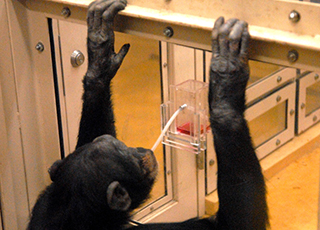January 31, 2013

From left, Program-Specific Assistant Prof. Yamamoto and Associate Prof. Tanaka
Chimps can learn more efficient ways to use a tool by watching what others do, according to research published January 30 in the open access journal PLOS ONE by Program-Specific Assistant Professor Shinya Yamamoto, Associate Professor Masayuki Tanaka and colleagues from Kyoto University, Japan, and Kent University, UK. Their study presents the first experimental evidence that chimps, like humans, can watch and learn a group member's invention of a better technique.
Summary
Chimps in the study were provided juice-boxes with a small hole and straws to drink with. One group of chimps used the straws like dipsticks, dipping and removing them to suck on the end, while the other group learned to suck through the straw directly. Learning both techniques required the same cognitive and motor skills, but chimps that drank through the straw got considerably more juice in a shorter amount of time. When the first group of chimps watched either a human or a chimp demonstrate the more efficient 'straw-sucking' technique, all of them switched to using this instead. The study concludes, "When chimpanzees are dissatisfied with their own technique, they may socially learn an improved technique by closely observing a proficient demonstrator."

Both the "dipping" and "straw-sucking" techniques entailed the same tool (straw-tube), the same target (juice), and exactly the same location (small hole). Actually in the scene depicted in this photo, the chimpanzee thereafter retrieved the tube and licked its tip ("dipping").
According to the authors, their results provide insights into the cognitive basis for the evolution of cumulative culture in chimpanzees, and suggest ways that culture could evolve in non-human animals.
Journal Information
Title
Basis for cumulative cultural evolution in chimpanzees: social learning of a more efficient tool-use technique
Authors
Yamamoto S, Humle T, Masayuki T

